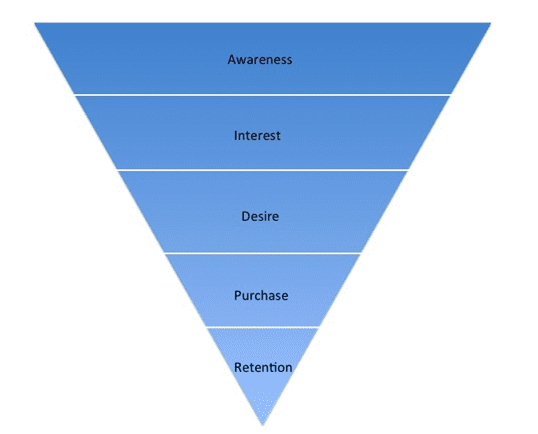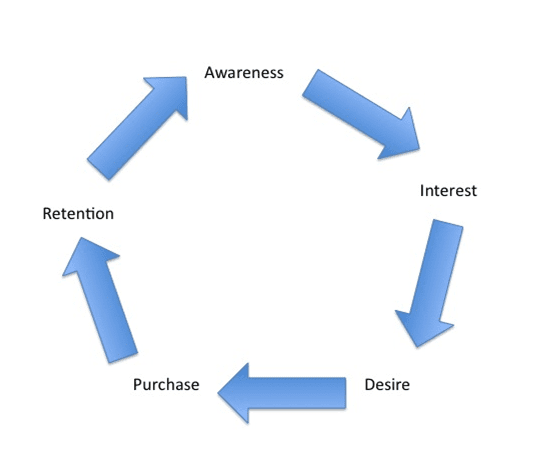Reviewing the role of social media in CRM
Most brands understand the concept of promotion using social media but few understand how to attribute value in the same way as traditional broadcast media.
With the rise of the internet, customers have more choice and have access to more information. Not only are customers far more media savvy and less likely to buy into brand marketing, but they are making more and more purchase decisions based on their value set rather than need alone.
This works the same way for B2B as well as B2C brands, whether it be a product or service, we like to buy from a brand based on need fit but also our experience of the organisation. Factors such as personal recommendations, customer service experience and how well the brand values match our own are now key triggers for deciding on a brand's worth.
The traditional purchase process

The way customers became aware of our products and decided to buy has historically been a fairly linear process often referred to as the purchase funnel. Customers would be filtered out and pulled in at each stage until the product matched the customer's desire and a purchase was made.
The stages were fairly clear cut and brands could allocate their marketing resources effectively to each stage. The focus was on the sale and it was relatively easy to understand how specific promotional activities could be attributed to the purchase process.
With the rise of social and the way customers now research and decide on a purchase, the 'funnel' has changed significantly and instead of it being a staged linear process, we find consumers take a far more considered approach, seeking information from a wider variety of places.
The new purchase cycle

We now refer to the purchase process as a cycle and customers can move forward or backwards throughout this cycle.
Social now allows the consumer to remain within the cycle long after the purchase has been made. Customer retention and loyalty are now as much of a focus as the sale itself.
We see many brands adopting social as a way to engage with customers and we recently spoke to BT’s Bian Salins about their hugely successful social media customer service channel.
What social media has allowed customers to have is a voice and a chance to make that voice heard. If we look at the different purchase stages we can consider how social can support customers and help you as a brand to promote your product or service at each stage.
Purchasing Stages through the AIDAR funnel
Getting your brand noticed is the first step and this means promotion. While traditionally this would have meant advertising of some description, social offers us the opportunity to move beyond clever (and expensive) marketing to activities which actively engage with our customers.
Make your brand visible on social media, create a brand page on Facebook and set up a Twitter feed. Go beyond sharing marketing messages and just talk to your customers about things you think they would be interested in. It doesn't have to be your products specifically, it could be anything that you can relate back in some way.
At this stage your customer has an interest in your product or service. This is the point when consumers will begin to search for something specific, probably online, and begin their research. Depending on the value of the item this research could be significant and will include looking at customer ratings, personal recommendations, availability and location etc.
Research has shown that when consumers are faced with a brand website and their Facebook page in search results a significant proportion will go to a social media site first. The reason for this is the idea that the content will be more relevant and more truthful. Facebook is where customers compliment or complain about a brand, where questions are answered and where the brand is seen to interact without the assumed agenda of just hard selling.
It's a trusted source for new customers and helps to either give confidence to a prospective customer or put them off.
This is where you move beyond the practical pairing of product and need to make the emotional connection between the consumer and your brand or product. Whether this be the product or service itself or your brand as the provider of choice, connect with your customers on a level that goes deeper than just being informative.
Solve your customer's problems, answer their questions, invest in them pre-sale and you will reap the rewards in the long term. This isn't about manipulating your customers, they can spot a faker a mile away.
In order to connect with your customers you need to offer genuine enthusiasm and interest which gives your brand the personality needed to inspire consumers.
All of this support needs to be instant and far more subtle than your corporate website will allow. Hosting these conversations on social media can make your customer feel like they are on neutral ground, you're in their space rather than the other way around.
Research shows that the greatest influence on customer purchase is recommendations from family and friends. This works both ways with a single negative opinion causing the opposite effect.
Managing your customers through the purchase process to ensure they have a positive experience will bring you far greater rewards in the future. Turning customers into loyal Advocates is the holy grail for any consumer or B2B brand, getting your customers to say good things about you and recommend you to a friend is probably easier than you think.
And this doesn't mean you can always prevent negative opinion being expressed about your brand, in fact nobody would believe it if you didn't have a single complaint about a product or service. But how you respond to those comments (and respond you must) will say more about your company than any self promotion can do. Social media is where conversations are happening, where customers are sharing their experiences, making recommendations and discussing their personal experiences of your brand.
Not engaging on these platforms doesn't mean the conversations aren't happening, it just means you're not a part of them.
Creating opportunities for long term mutually beneficial relationships is what social media was made for. Customer care post purchase is just as important as the support you offer during the selling process. Once a customer has selected you as a supplier don't let them just walk away, build on the connection that now exists, provide opportunities for feedback, follow up support, issue management and reviews.
Every time a customer interacts with your social network profile, it sends a ripple of notifications throughout that individual's network, telling everyone they know that they've spent some of their precious time talking to you. A vote of confidence can be all it takes to bring in new customers to your brand rather than somebody else's.
Social media can be your best asset when it comes to customer service and support. It offers a mix of real time responses, an open forum which engenders trust and the opportunity for uncensored voices to be heard. It feels far more like an area owned by the customer than your branded website could ever achieve.

Thanks to
Daniel Rowles for sharing his advice and opinions in this post. Daniel is Managing Director of
Target Internet and host of the popular
Digital Marketing Podcast. You can follow him on
Twitter or connect on
LinkedIn.





 Thanks to
Thanks to 


